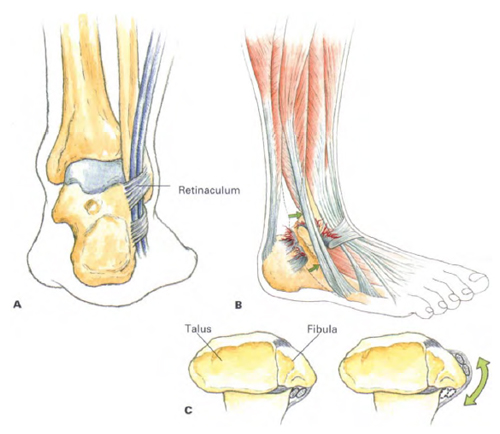Repetitive Stress Injuries Plague the Manufacturing and Customer Service Based Industries. RSI’s cost US employers on average over 1 billion U S Dollars per year.
(A) Posterior view of normal peroneal tendon anatomy. (B) Lateral view of retinaculum injury. (C) Crosssectional
view of tendon dislocation.
Current estimates suggest that repetitive strain injury (RSI) conditions cost UK industry between £5bn and £20bn every year.
Symptoms of RSI can include numbness, swelling, pain, stiffness, weakness or tingling in the shoulders, back, neck, hands, wrists, elbows and lower limbs.
Typically, discomfort brought on by a particular task will improve when it is stopped i.e. if the pain lessens or disappears over weekends or during holidays. If the discomfort begins in one area but then spreads to other parts of the body this may manifest as sore shoulders, neck pain, stiffness in the limbs and hands. The earlier RSI is detected, the greater the likelihood that the condition can be reversed or symptoms can be eased.
If you have been diagnosed with RSI, the typical treatment is to rest the limb from aggravating factors (especially the task(s) that incited the condition). Your physician may also recommend painkillers/anti-inflammatories, physiotherapy, massage, ultrasound or even surgery in some cases.
Ankle Tendon Treatments
Allowing your ankle to rest is always recommended when you are suffering from tendinitis, tendon tear or bone dislocation. Avoid all activities that may have caused the injury or irritation and begin cold compression treatments as soon as possible. The peroneal and posterior tibial tendons are difficult to rest completely as they are essential tendons for walking and daily activities. During your recovery, you will probably have to modify and/or eliminate any activities that cause pain or discomfort in your ankle until the pain and inflammation settle.
The trick with healing an ankle tendon injury is getting it to heal with minimal scar tissueformation. Even with optimum healing, there is always less elasticity in previously injured peroneal tendons. This will cause the tendons to hurt during daily activities and exercise. However, if you heal your ankle tendons efficiently and quickly, your chance of re-injury later on is much lower than average.
Fortunately, there are healing tools that can help treat your peroneal and posterior tibial tendons and speed up the healing process so you can get back to a life without pain and risk of further injury. Blood Flow Stimulation Therapy™ (BFST®) promotes blood flow to heal your tendons faster and more completely than any other methods available.
